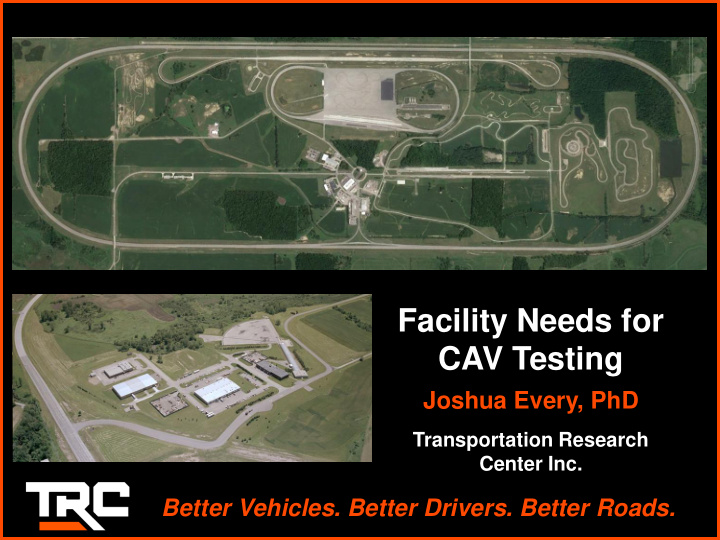



Facility Needs for CAV Testing Joshua Every, PhD Transportation Research Center Inc. Better Vehicles. Better Drivers. Better Roads.
Fundamentals of Automated Vehicle (AV) Testing – AV testing is different from other forms of vehicle testing • Driver inputs no longer dictate vehicle behavior, environments do – To appropriately test automation algorithms, vehicles need to be immersed in the desired environment – The availability of specific environments dictates which tests can be performed Better Vehicles. Better Drivers. Better Roads.
Central Question What features are desired for testing Connected Automated Vehicles (CAVs)? Better Vehicles. Better Drivers. Better Roads.
Central Question Better Vehicles. Better Drivers. Better Roads.
Central Question - Revised What features are necessary for testing Connected Automated Vehicles (CAVs)? Better Vehicles. Better Drivers. Better Roads.
Stakeholder Survey • In order to answer this question TRC conducted a large user survey Participants from government and industry • Questions were asked based on what test scenarios were desired Resulted in a very large amount of data • This information was initially reduced by identifying the course features necessary for each test scenario Better Vehicles. Better Drivers. Better Roads.
Features Necessary Better Vehicles. Better Drivers. Better Roads.
Sorted by Environment Better Vehicles. Better Drivers. Better Roads.
Main Environments with Features Better Vehicles. Better Drivers. Better Roads.
Main Environments Better Vehicles. Better Drivers. Better Roads.
Example test Scenarios Suburban First/Last mile Urban Path planning Vehicles parked on street Limited lines of sight and substantial background scatter Highway Merging/ exiting Lane shifts Platooning Intersection Intersection collision avoidance Freight preference Determining right of way – Four way stop – Right on red Rural Tighter curves than on highway Tree cover/ limited lines of sight Better Vehicles. Better Drivers. Better Roads.
Example test Scenarios Parking lot Parallel and perpendicular parking Navigating with limited reference points Tunnel Sharp changes in lighting Signal blocking/ reflection Temporary courses Defined with cones or stripes to create unique geometries Other road users Pedestrians Cyclists Animals Environmental Effects of environmental conditions on sensors Behavior of control algorithms under different roadway conditions – Low friction, obscured lane markings, etc. ITS Deployable RSUs to add infrastructure connectivity to all testing environments Better Vehicles. Better Drivers. Better Roads.
A SMART Ecosystem for Connected & Autonomous Vehicles ITY CORRIDOR TRC SMART CENT SMART MOB MOBIL ILITY ENTER ER Better Vehicles. Better Drivers. Better Roads.
N The SMART Center Better Vehicles. Better Drivers. Better Roads.
N Urban Network Wooded Road Phase 1 completion in 2017 The SMART Center Better Vehicles. Better Drivers. Better Roads.
N Urban Network Wooded Road Phases 2 & 3 The SMART Center Better Vehicles. Better Drivers. Better Roads.
Better Vehicles. Better Drivers. Better Roads.
Recommend
More recommend